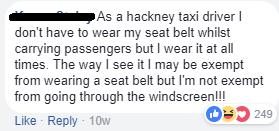Ordinary drivers could be forgiven for thinking that putting a seat belt on when you get in a car is simply second nature. You get in, you strap your seat belt on. That, you might have thought, is all there is to it. But among professional drivers, the reality is in fact somewhat different.
A recent poll on the Teletrac Navman UK Facebook page uncovered some interesting findings on attitudes among professional drivers towards seat belts and when – or indeed whether – to wear them. The question posed was as follows: “When is it acceptable (if ever) for professional drivers not to wear a seatbelt?”
The poll provided respondents with four options: over a short distance (between 50-100 metres), at low speeds (i.e. below 20mph), off public roads, or when drivers are frequently in and out of their cab.
In total, 360 people voted in the poll. Of these, 152 (42%) said that they felt it was acceptable for professional drivers not to wear a seatbelt in situations where they were regularly leaving and re-entering their cab. Meanwhile, 101 (28%) of respondents felt that it was acceptable for them not to wear seatbelts when making journeys of 50-100 metres. A further 95 (26%) thought it was acceptable to do so when not travelling on public roads, while only a handful considered it acceptable when driving at less than 20mph.
The issue prompted another lively debate in the ensuing comments thread. Many respondents were unequivocal in their views on the matter; as far as they’re concerned, there is no excuse for those who drive for a living not wearing a seatbelt when behind the wheel – after all, you just can’t legislate for the behaviour of some road users.


Others, meanwhile, felt that not wearing a seatbelt when driving simply didn’t feel right, having got so used to doing so:

However, there were a few who admitted that they tended not to wear seatbelts when they were out and about on the job:

There are various exemptions to wearing seat belts, whether on medical or other grounds. Drivers in vehicles specially adapted for delivering goods and mail to consumers are not legally obliged to wear seat belts when conducting local delivery rounds (travelling no more than 50 metres between stops), though they must wear a seat belt when on their way to or from that round. Also, all drivers are exempt from having to wear seat belts when performing a manoeuvre that includes reversing (such as a three-point turn), though they must put a seat belt on as soon as the manoeuvre has been completed.
Even so, the fact that there are so many drivers who are, for whatever reason, reluctant to wear a seatbelt when working really underlines the need for fleet operators to take a proactive approach when it comes to driver safety. Devising a comprehensive approach to training and education, and creating a culture of road safety, are both essential to help ensure that drivers take their responsibilities to their own safety and that of other road users seriously.
It's well known that telematics technology offers fleet managers enormous amounts of insight into the way their drivers behave on the roads, allowing them to highlight and develop strategies for tackling dangerous or risky forms of conduct. The latest telematics systems can also offer seat belt monitoring, providing a full overview of driver seat belt usage – allowing managers to identify which drivers don’t wear seat belts through real-time alerts and scheduled reporting, enabling them to address repeated breaches where they occur. As part of a wider road safety strategy incorporating training programmes tailored to address the needs and shortcomings of individual drivers, this can make a major positive difference to driver safety.

